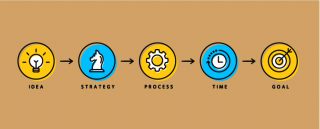Clarity, vision, empowerment, communication, consistency, sustainability – the ingredients you need for effective change management.
When working with one of India’s largest PR agencies at the time, the agency was bought out by a larger global entity with an entirely different culture. I was interested in seeing how the integration was going to be done and more significantly, at what level. While due processes were done with HR, IT and other such important support functions, I was keener to see when the cultural shift would be advanced. Strangely, there was no indoctrination or exchange of understanding when it came to the differences in the cultures that the organisations embodied. Culture was the critical part so it was more than wondrous that no attention was paid to it.
Culture, like strategy is an overused word, used by people who most times don’t have their basics right. Forget the clinical definitions of culture, a quick search will reveal not just many versions but the interesting thing is that most of it point to similar values that build culture.
Simply put, what then is culture? The way organisations behave, the values they uphold and the way they structure themselves is merely one part of it and a lot of it is given to optics. The deeper you go, understanding dawns that culture drives who you are, what you want to achieve internally and externally, how you plan to get there or the vision of the organisation, when you plan to get there which is the timeline, which processes you use to realise your ambitions and to me the most critical parts are why and do you know who your target audiences are.
Why are you in this business, why do you choose the processes you do, why is your vision what it is; are you aware of who you are talking or reaching out to and what is the key messaging you are putting out there that is relevant to each set of your audience. If you are successful in answering these questions, you have your foundation set at the very least. The rest is in ensuring consistent implementation of these parameters.
While working in a global manufacturing firm the vision was clear and one of the few examples of an organisation where the vision percolated to the last man and woman on the shop floor. The values when driven by the older set of top management succeeded to a large extent and the customer centric nature of the sales vision ensured that the company grew from strength to strength. But with newer generations taking over slowly, the vision started to give way and got weaker plus the lack of focus on communication meant that internally and externally, perception was created by whatever was put out there and the rest, which was the larger piece, was assumed. Here again, change was supposed to be the only constant but within the practice of it this turned out to be lip service.
Change management and communication are inextricably linked; you cannot leave out communication when there is change afoot. Doing that makes it a sure shot recipe for disaster and crisis. This communication is uber critical at an internal level – employees not only should know but have the right to know what changes are going to be implemented, how, when and the impact on them individually and as departments or business units.
How then do you communicate change to your teams? With the increasing adoption of technology, it has made it far easier for communication to take place on multiple platforms. The change can be something as fundamental as a new process or slightly larger in scale like rebranding. Changes can come in many forms including change in management, changes like acquisitions or mergers, changes in protocol among others.
Lay out a clear blueprint of tasks to be done, assign responsibilities and timelines and use your middle management and team leads as conduits to ensure seamless transitions. If something as critical as gaining independence led us down the path to change, doing this within an organisation is a relatively smaller task. Lessons can be learned from history and implementing them becomes the important part. Especially when it comes to avoiding mistakes made.
Empower team leads to steer the change and decide what is best for their divisions, businesses and people. Don’t micromanage it; that sort of approach inevitably leads to demotivated team morale. If you can create modules right from the start that lay out the dos and don’ts it becomes that much easier to promote change.
Talk to your employees that must embrace the change, see what kind of resistance is being felt. Keeping the channels of communication open is the best way to ensure that speed of adoption is felt and practiced. Leadership plays a crucial role in this journey. The right kind of leader will demonstrate through leading by example, which is the best way to get employees on your side.
Use social media to promote the need for change and the path to it through videos, posts and variegated story telling methods preferably getting your employees to do it so that there is a greater sense of belonging and ownership. Use channels like town halls to tell the story of change with anecdotes from your own organisation and others including competition to demonstrate the importance of the changes you are making. Use creative ways to tell this story effectively and repeat as many times as needed.
Posters around the offices along with desktop material like tent cards, screensavers and stickers help reiterate the messages.
These are different ways of promoting and managing change within organisations. The most important element though will be consistency and ensuring not just implementation but sustainability. Remember that all change is change but the ones that stick are the ones that can be easily made. So, here’s to change and its ever-changing nature.
About the author: Padma Venkataraman has been in and about the business for communication for over 20 years. With an analytical mind that marries the rare combination of seeing the bigger picture while being anal about the details, her career has embraced advertising, content, film, journalism, PR and Corporate Communications in senior roles. Padma has currently turned entrepreneur and offers consultation on brand management, change management, internal communications, storytelling, content, social media, films and events.














